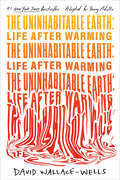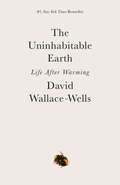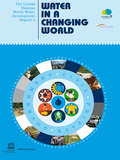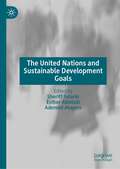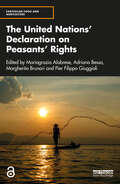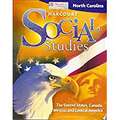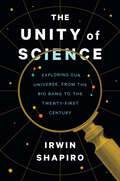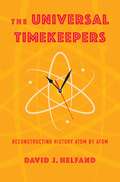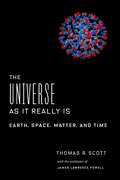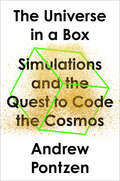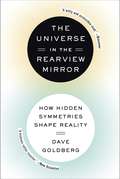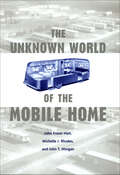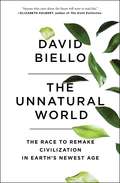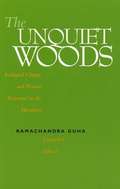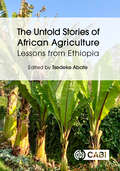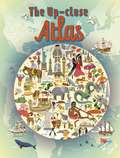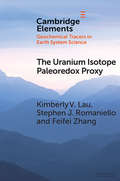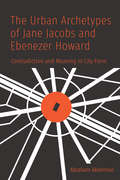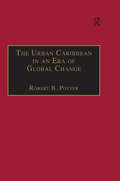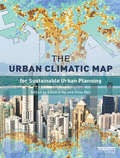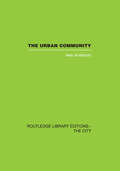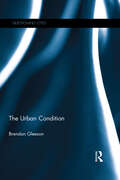- Table View
- List View
The Uninhabitable Earth (Adapted for Young Adults): Life After Warming
by David Wallace-WellsAn exploration of the devastating effects of global warming—current and future—adapted for young adults from the #1 New York Times bestseller. This is not only an assessment on how the future will look to those living through it, but also a dire overview and an impassioned and hopeful call to action to change the trajectory while there is still time. The climate crisis that our nation currently faces, from rising temperatures, unfathomable drought, devastating floods, unprecedented fires, just to name a few, are alarming precursors to what awaits us if we continue on our current path. In this adaptation for young adults from the #1 New York Times bestseller, journalist David Wallace-Wells tells it like it is, and it is much worse than anyone might think. Global warming is effecting the world, if left unchecked, it promises to transform global politics, the meaning of technology and the trajectory of human progress. In sobering detail, Wallace-Wells lays out the mistakes and inaction of past and current generations that we see negatively affecting all lives today and more importantly how they will inevitably affect the future. But readers will also hear—loud and clear—his impassioned call to action, as he appeals to current and future generations, especially young people. As he states: &“the solutions, when we dare to imagine them . . . are indeed motivating, if there is to be any chance of preserving even the hope for a happier future—relatively livable, relatively fulfilling, relatively prosperous, and perhaps more than only relatively just.&”
The Uninhabitable Earth: Life After Warming
by David Wallace-WellsIt is worse, much worse, than you think. If your anxiety about global warming is dominated by fears of sea-level rise, you are barely scratching the surface of what terrors are possible. In California, wildfires now rage year-round, destroying thousands of homes. Across the US, “500-year” storms pummel communities month after month, and floods displace tens of millions annually. <p><p> This is only a preview of the changes to come. And they are coming fast. Without a revolution in how billions of humans conduct their lives, parts of the Earth could become close to uninhabitable, and other parts horrifically inhospitable, as soon as the end of this century. <p> In his travelogue of our near future, David Wallace-Wells brings into stark relief the climate troubles that await—food shortages, refugee emergencies, and other crises that will reshape the globe. But the world will be remade by warming in more profound ways as well, transforming our politics, our culture, our relationship to technology, and our sense of history. It will be all-encompassing, shaping and distorting nearly every aspect of human life as it is lived today. <p> Like An Inconvenient Truth and Silent Spring before it, The Uninhabitable Earth is both a meditation on the devastation we have brought upon ourselves and an impassioned call to action. For just as the world was brought to the brink of catastrophe within the span of a lifetime, the responsibility to avoid it now belongs to a single generation. <p><b>A New York Times Bestseller</b>
The United Nations World Water Development Report 3: Water in a Changing World (Two Vols.)
by World Water World Water Assessment ProgrammeThe United Nations World Water Development Report, published every three years, is a comprehensive review providing an authoritative picture of the state of the world's freshwater resources. It offers best practices as well as in-depth theoretical analyses to help stimulate ideas and actions for better stewardship in the water sector. It is the only report of its kind, resulting from the collaboration and contributions of the 26 UN agencies, commissions, program, funds, secretariats and conventions that have a significant role in addressing global water concerns. The news media are full of talk of crises - in climate change, energy and food and troubled financial markets. These crises are linked to each other and to water resources management. Unresolved, they may lead to increasing political insecurity and conflict. Water is required to meet our fundamental needs and rising living standards and to sustain our planet‘s fragile ecosystems. Pressures on the resource come from a growing and mobile population, social and cultural change, economic development and technological change. Adding complexity and risk is climate change, with impacts on the resource as well as on the sources of pressure on water. The challenges, though substantial, are not insurmountable. The Report shows how some countries have responded. Progress in providing drinking water is heartening, with the Millennium Development Goal target on track in most regions. But other areas remain unaddressed, and after decades of inaction, the problems in water systems are enormous and will worsen if left unattended. Leaders in the water sector can inform decisions outside their domain and manage water resources to achieve agreed socioeconomic objectives and environmental integrity. Leaders in government, the private sector and civil society determine these objectives and allocate human and financial resources to meet them. Recognizing this responsibility, they must act now! Two volume set: 336
The United Nations and Sustainable Development Goals
by Sheriff Folarin Esther Akinlabi Aderemi AtayeroThe book is a collection of analyses on country-specific and universal efforts, programmes and projects from Africa and beyond, aimed at realising the Sustainable Development Goals (SDGs). Specifically, the chapters focus on the achievements and challenges that can potentially aid countries of the world and the United Nations in achieving the 17 SDGs. The chapters focus more on the challenges, prospects and concrete steps taken in the Global South towards the attainment of these goals.
The United Nations' Declaration on Peasants' Rights (Earthscan Food and Agriculture)
by Mariagrazia Alabrese Margherita Brunori Adriana Bessa Pier Filippo GiuggioliThis is the first book to address and review the United Nations' Declaration on the Rights of Peasants and Other People Working in Rural Areas (UNDROP), which was adopted by the United Nations General Assembly in December 2018. Food security and sustainable agri-food systems, responsible governance of natural resources, and human rights are among the key themes of the new millennium. The Declaration is the first internationally negotiated instrument bridging these issues, calling for a radical paradigm change in the agricultural sector while giving voice to peasants and rural workers, recognised as the drivers of more equitable and resilient food systems. The book unfolds the impact of the Declaration in the wider realm of law and policy making, especially concerning the new human rights standards related to access and control of natural resources and the governance of food systems. The chapters in the book touch on a broad array of topics, including women’s rights, the role of and impact on indigenous peoples, food sovereignty, climate change, land tenure, and agrobiodiversity. Voices from outstanding scholars and practitioners are gathered together to inform and trigger a further debate on the negotiation process, the innovative and potentially disruptive contents, the relations with other fields of law, and the practical scope of the Declaration. The volume concludes with a collection of case studies that provide concrete examples to help us understand the potential impacts of the Declaration at regional, national, and local levels. This book is the first comprehensive tool to navigate the Declaration and is designed for students, researchers, and practitioners in the fields of food and agriculture law, peasant, agrarian and rural studies, human rights and environmental law, and international development and cooperation.
The United States in a Warming World
by Thomas L. BrewerAddressing the widespread desire to better understand how climate change issues are addressed in the United States, this book provides an unparalleled analysis of features of the US economic and political system that are essential to understanding its responses to climate change. The introductory chapter presents a firm historical context, with the remainder of the book offering balanced and factual discussions of government, business and public responses to issues of energy policies, congressional activity on climate change, and US government involvement in international conferences. Abundant statistical evidence illustrates key concepts and supports analytic themes such as market failures, free riders, and the benefits and costs of alternative courses of action among industry sectors and geographic areas within the US. Written for audiences both outside and within the US, this accessible book is essential reading for anyone interested in climate change, energy, sustainable development or related issues around the world.
The United States, Canada, Mexico, and Central America
by Michael J. Berson Tyrone C. Howard Cinthia SalinasNIMAC-sourced textbook
The Unity of Science: Exploring Our Universe, from the Big Bang to the Twenty-First Century
by Irwin ShapiroA journey guided by science that explores the universe, the earth, and the story of life For Irwin Shapiro, science starts with questions. This book provides a broad and entertaining survey of major scientific discoveries that have changed our views of nature and, in turn, spawned further questions. Shapiro, an award-winning scientist and beloved teacher, separates his inquiry into three parts: looking up at the universe; looking down at the earth and its fossils; and looking in at the story of life. His framework encourages readers to view science as a detective story—to observe and question nature and natural phenomena, and to base all conclusions on scientific evidence. With his knowledgeable yet conversational approach, Shapiro offers an enjoyable way for the curious to learn about the foundations of a range of scientific topics: the motions of bodies in the cosmos, the history and structure of the earth, the evolution of organisms, and the search for extraterrestrial life and intelligence.
The Universal Timekeepers: Reconstructing History Atom by Atom
by David HelfandAtoms are unfathomably tiny. It takes fifteen million trillion of them to make up a single poppy seed—give or take a few billion. And there’s hardly anything to them: atoms are more than 99.9999999999 percent empty space. Yet scientists have learned to count these slivers of near nothingness with precision and to peer into their internal states. In looking so closely, we have learned that atoms, because of their inimitable signatures and imperturbable internal clocks, are little archives holding the secrets of the past.David J. Helfand reconstructs the history of the universe—back to its first microsecond 13.8 billion years ago—with the help of atoms. He shows how, by using detectors and reactors, microscopes and telescopes, we can decode the tales these infinitesimal particles tell, answering questions such as: Is a medieval illustrated prayer book real or forged? How did maize cultivation spread from the highlands of central Mexico to New England? What was Earth’s climate like before humans emerged? Where can we find clues to identify the culprit in the demise of the dinosaurs? When did our planet and solar system form? Can we trace the births of atoms in the cores of massive stars or even glimpse the origins of the universe itself?A lively and inviting introduction to the building blocks of everything we know, The Universal Timekeepers demonstrates the power of science to unveil the mysteries of unreachably remote times and places.
The Universe Speaks in Numbers: How Modern Math Reveals Nature's Deepest Secrets
by Graham FarmeloHow math helps us solve the universe's deepest mysteries One of the great insights of science is that the universe has an underlying order. The supreme goal of physicists is to understand this order through laws that describe the behavior of the most basic particles and the forces between them. For centuries, we have searched for these laws by studying the results of experiments. Since the 1970s, however, experiments at the world's most powerful atom-smashers have offered few new clues. So some of the world's leading physicists have looked to a different source of insight: modern mathematics. These physicists are sometimes accused of doing 'fairy-tale physics', unrelated to the real world. But in The Universe Speaks in Numbers, award-winning science writer and biographer Farmelo argues that the physics they are doing is based squarely on the well-established principles of quantum theory and relativity, and part of a tradition dating back to Isaac Newton. With unprecedented access to some of the world's greatest scientific minds, Farmelo offers a vivid, behind-the-scenes account of the blossoming relationship between mathematics and physics and the research that could revolutionize our understanding of reality. A masterful account of the some of the most groundbreaking ideas in physics in the past four decades. The Universe Speaks in Numbers is essential reading for anyone interested in the quest to discover the fundamental laws of nature.
The Universe as It Really Is: Earth, Space, Matter, and Time
by Dr Thomas R. ScottThe universe that science reveals to us can seem far outside the comfort zone of the human mind. Subjects near and far open up dizzying vistas, from the infinitesimal to the colossal. Humanity, the unlikely product of uncountable coincidences on unimaginable scales, inhabits a tumultuous universe that extends from our immediate environs to the most distant galaxies and beyond. But when the mind balks at the vertiginous complexity of the universe, science unveils the elegance amid the chaos.In this book, Thomas R. Scott ventures into the known and the unknown to explain our universe and the laws that govern it. The Universe as It Really Is begins with physics and the building blocks of the universe—time, gravity, light, and elementary particles—and chemistry’s ability to explain the interactions among them. Scott, with the assistance of James Lawrence Powell, next tours the earth and atmospheric sciences to explain the forces that shape our planet and then takes off for the stars to describe our place in the cosmos. He provides vivid introductions to our collective scientific inheritance, narrating discoveries such as the shape of the atom and the nature of the nucleus or how we use GPS to measure time and what that has to do with relativity. A clear demonstration of the power of scientific reasoning to bring the incomprehensible within our grasp, The Universe as It Really Is gives an engrossing account of just how much we do understand about the world around us.
The Universe in a Box: Simulations and the Quest to Code the Cosmos
by Andrew PontzenScientists are using simulations to recreate the universe, revealing the hidden nature of reality.Cosmology is a tricky science—no one can make their own stars, planets, or galaxies to test its theories. But over the last few decades a new kind of physics has emerged to fill the gap between theory and experimentation. Harnessing the power of modern supercomputers, cosmologists have built simulations that offer profound insights into the deep history of our universe, allowing centuries-old ideas to be tested for the first time. Today, physicists are translating their ideas and equations into code, finding that there is just as much to be learned from computers as experiments in laboratories. In The Universe in a Box, cosmologist Andrew Pontzen explains how physicists model the universe&’s most exotic phenomena, from black holes and colliding galaxies to dark matter and quantum entanglement, enabling them to study the evolution of virtual worlds and to shed new light on our reality. But simulations don&’t just allow experimentation with the cosmos; they are also essential to myriad disciplines like weather forecasting, epidemiology, neuroscience, financial planning, airplane design, and special effects for summer blockbusters. Crafting these simulations involves tough compromises and expert knowledge. Simulation is itself a whole new branch of science, one that we are only just beginning to appreciate and understand. The story of simulations is the thrilling history of how we arrived at our current knowledge of the world around us, and it provides a sneak peek at what we may discover next.
The Universe in the Rearview Mirror
by Dave GoldbergA physicist speeds across space, time and everything in between showing that our elegant universe--from the Higgs boson to antimatter to the most massive group of galaxies--is shaped by hidden symmetries that have driven all our recent discoveries about the universe and all the ones to come. Why is the sky dark at night? Is it possible to build a shrink-ray gun? If there is antimatter, can there be antipeople? Why are past, present, and future our only options? Are time and space like a butterfly's wings? No one but Dave Goldberg, the coolest nerd physicist on the planet, could give a hyper drive tour of the universe like this one. Not only does he answer the questions your stoner friends came up with in college, but he also reveals the most profound discoveries of physics with infectious, Carl Sagan-like enthusiasm and accessibility. Goldberg's narrative is populated with giants from the history of physics, and the biggest turns out to be an unsung genius and Nazi holocaust escapee named Emmy Noether--the other Einstein. She was unrecognized, even unpaid, throughout most of her career simply because she was a woman. Nevertheless, her theorem relating conservation laws to symmetries is widely regarded to be as important as Einstein's notion of the speed of light. Einstein himself said she was "the most significant creative mathematical genius thus far produced since the higher education of women began." Symmetry is the unsung great idea behind all the big physics of the last one hundred years--and what lies ahead. In this book, Goldberg makes mindbending science not just comprehensible but gripping. Fasten your seat belt.
The Unknown World of the Mobile Home (Creating the North American Landscape)
by John Fraser Hart Michelle J. Rhodes John T. MorganIn American popular imagination, the mobile home evokes images of cramped interiors, cheap materials, and occupants too poor or unsavory to live anywhere else. Since the 1940s and '50s, however, mobile home manufacturers have improved standards of construction and now present them as an affordable alternative to conventional site-built homes. Today one of every fourteen Americans lives in a mobile home. In The Unknown World of the Mobile Home authors John Fraser Hart, Michelle J. Rhodes, and John T. Morgan illuminate the history and culture of these often misunderstood domiciles. They describe early mobile homes, which were trailers designed to be pulled behind automobiles and which were more often than not poorly constructed and unequal to the needs of those who used them. During the 1970s, however, Congress enacted federal standards for the quality and safety of mobile homes, which led to innovation in design and the production of much more attractive and durable models. These models now comply with local building codes and many are designed to look like conventional houses. As a result, one out every five new single-family housing units purchased in the United States is a mobile home, sited everywhere from the conventional trailer park to custom-designed "estates" aimed at young couples and retirees. Despite all these changes in manufacture and design, even the most immobile mobile homes are still sold, financed, regulated, and taxed as vehicles.With a wealth of detail and illustrations, The Unknown World of the Mobile Home provides readers with an in-depth look into this variation on the American dream.
The Unnatural World: The Race to Remake Civilization in Earth's Newest Age
by David BielloWith the historical perspective of The Song of the Dodo and the urgency of Al Gore's An Inconvenient Truth, a brilliant young environmental journalist argues that we must innovate and adapt to save planet Earth.Civilization is in crisis, facing disasters of our own making on the only planet known to bear life in the vast void of the universe. We have become unwitting gardeners of the Earth, not in control, but setting the conditions under which all of life flourishes--or not. Truly, it's survival of the innovators. The Unnatural World chronicles a disparate band of unlikely heroes: an effervescent mad scientist who would fertilize the seas; a pigeon obsessive bent on bringing back the extinct; a low-level government functionary in China doing his best to clean up his city, and more. These scientists, billionaires, and ordinary people are all working toward saving the best home humanity is ever likely to have. What is the threat? It is us. In a time when a species dies out every ten minutes, when summers are getting hotter, winters colder, and oceans higher, some people still deny mankind's effect on the Earth. But all of our impacts on the planet have ushered in what qualifies as a new geologic epoch, thanks to global warming, mass extinction, and such technologies as nuclear weapons or plastics. The Unnatural World examines the world we have created and analyzes the glimmers of hope emerging from the efforts of incredible individuals seeking to change our future. Instead of a world without us, this history of the future shows how to become good gardeners, helping people thrive along with an abundance of plants, animals, all the exuberant profusion of life on Earth--a better world with us. The current era of humans need not be the end of the world--it's just the end of the world as we know it.
The Unquiet Woods: Ecological Change and Peasant Resistance in the Himalaya
by Ramachandra GuhaThe Unquiet Woods, Ramachandra Guha's path breaking study of peasant movements against commercial forestry, offers a new epilogue that brings the story of Himalayan social protest up-to-date, reflecting the Chipko movement's continuing influence in the wider world.
The Unsettling of Europe: How Migration Reshaped a Continent
by Peter GatrellAn acclaimed historian examines postwar migration's fundamental role in shaping modern Europe Migration is perhaps the most pressing issue of our time, and it has completely decentered European politics in recent years. But as we consider the current refugee crisis, acclaimed historian Peter Gatrell reminds us that the history of Europe has always been one of people on the move. The end of World War II left Europe in a state of confusion with many Europeans virtually stateless. Later, as former colonial states gained national independence, colonists and their supporters migrated to often-unwelcoming metropoles. The collapse of communism in 1989 marked another fundamental turning point. Gatrell places migration at the center of post-war European history, and the aspirations of migrants themselves at the center of the story of migration. This is an urgent history that will reshape our understanding of modern Europe.
The Untold Stories of African Agriculture: Lessons from Ethiopia
by Melaku Admasu Seid Ahmed Kemal Getinet Alemaw Dessie Ambaw Gashawbeza Ayalew Workneh Ayalew Dr Amsalu Ayana Ashenafi Ayano Ferdu Azerefegne Endashaw Bekele Getachew Belay Terefe Belehu Mintewab Bezabih Asmare Dagnew Maru Degefa Mulat Demeke Minyahel Fekadu Daneal Fekersillassie Regassa Feyissa Asnake Fikre Messele Fisseha Amare Fufa Muluken Goftishu Endeshaw Habte Konjit Hailu Karta Karke Kalsa Girma Tesfahun Kassie Friew Kelemu Tolera Keno Rahwa Kidane Berga Lemaga Abebe Menkir Takele Negewo Hawani Negussie Mesfin Shenkut Amare Tegbaru Kindie Tesfaye Taye Tessema Melaku Wale Wondimagegnehu Mersie Zerihun Yemataw Firehun Yirefu Mikael Fisseha Yohannes Engida Zemedagegnehu Olubunmi A. BosseyThis landmark volume presents the results of a comprehensive and coherent in-depth assessment of Ethiopian agriculture and draws lessons from it to generate actionable recommendations that will inform policy decisions and priority setting for agricultural transformation across Africa. Policy makers in Africa are faced with the challenges of ensuring food and nutrition security and the economic wellbeing of their rapidly growing populations while at the same time maintaining the integrity of their natural resource base. Between 2000 and 2021, 74% of the growth in overall crop production on the continent was derived from increases in land area expansion, while increases in yield contributed only 26% of the growth. This unchecked expansion of land use puts the sustainability of the natural resource base under severe pressure. Even though some countries have made substantial increases in their farm productivity over the last two decades, the overall performance for Africa is far behind other regions. For the most part, in Africa, agriculture is not fulfilling its expected functions of food and nutrition security, increased export earnings, import substitution, and raw material supply for local industries. Attempts have been made to transform African agriculture over the years, but few countries have succeeded in achieving sustainable change. Using examples from Ethiopia this book identifies the major factors for success and the root causes of underperformance, and offers evidence-based recommendations for future decision making, policy change and the creation of growth. This book: · Draws on a unique set of case studies from Ethiopia described and told from a truly African perspective. · Emphasises to policy makers in Africa that development cannot be outsourced and there are no shortcuts; it is only through consistent effort and sustained support for their agricultural research and development that positive change can be brought about. · States that past agricultural development efforts by the international community have not properly included a strong African voice, and that therefore, all future academic research, policies and strategies dealing with the continent's agriculture and food security should be formulated by Africa's own leading thinkers and experts. · Is not a polemic; its arguments are knowledge and evidence based, building a compelling picture of how agricultural development can be sustained for the future.
The Up-close Atlas
by Paul RockettJourney around the globe and get up-close to the different cultures, geography and wildlife that make up our world.This unique illustrated book gets close up to the Earth's amazing continents, and allows readers the opportunity to explore key countries, topographical features and cities in a way that is both engaging and entertaining. In addition, the book highlights significant human, geographical, sporting and economic information, perfect for children aged 9+.With the help of fun artwork, illustrated maps, photos and facts, this atlas is a comprehensive guide to our planet and (almost) everything on it!
The Uranium Isotope Paleoredox Proxy (Elements in Geochemical Tracers in Earth System Science)
by Kimberly V. Lau Stephen J. Romaniello Feifei ZhangUranium isotopes (238U/235U) have emerged as a proxy to reconstruct the redox conditions of the Earth's oceans and atmosphere based upon the large isotopic fractionation between reduced U(IV) and oxidized U(VI). Variations in 238U/235U, particularly when recorded in carbonate sediments, can track global trends in marine oxygenation and de-oxygenation. It is unique from other proxies because reduction primarily occurs at the sediment-water interface, and this sensitivity makes U isotopes especially relevant for the habitability of benthic animals. This Element covers the background, methods, and case studies of this promising tool for understanding Earth's environmental transitions, as rapid development continues to refine the accuracy of interpretations of 238U/235U records.
The Urban Archetypes of Jane Jacobs and Ebenezer Howard: Contradiction and Meaning in City Form (G - Reference, Information And Interdisciplinary Subjects Ser.)
by Abraham AkkermanEbenezer Howard, an Englishman, and Jane Jacobs, a naturalized Canadian, personify the twentieth century’s opposing outlooks on cities. Howard had envisaged small towns, newly built from scratch, fashioned on single family homes with small gardens. Jacobs embraced existing inner-city neighbourhoods emphasizing the verve of the living street. From Howard’s idea, the American Dream of garden suburbs had emerged, yet his conceptualization of a modern city received criticism for being uniform and alienated from the rest of the city. Similarly, at the turn of the new century, Jacobs’ inner-city neighbourhoods came to be recognized as the result of commodification, vacillating between poverty and newly discovered hubs of urban authenticity. Presenting Howard and Jacobs within a psychocultural context, The Urban Archetypes of Jane Jacobs and Ebenezer Howard addresses our urban crisis in the recognition that "city form" is a gendered, allegorical medium expressing femininity and masculinity within two founding features of the built environment: void and volume. Both founding contrasts bring tensions, but also the opportunities of fusion between pairs of urban polarities: human scale against superscale, gait against speed, and spontaneity against surveillance. Jacobs and Howard, in their respective attitudes, have come to embrace the two ancient archetypes, the Garden and the Citadel, leaving it to future generations to blend their two contrarian stances.
The Urban Caribbean in an Era of Global Change
by Robert B. PotterBased on the author’s first hand field research, this book addresses the twin processes of urbanization and globalization as they affect the contemporary Caribbean region. One of the key aims of the book is to focus attention on the fact that contrary to popular perceptions, the Caribbean is highly urbanized. Indeed statistics show that the region is more highly urbanized than the world taken as a whole. In addition, the fact that the Caribbean region has always been affected by processes of globalization, in respect of its economy, polity and society, is central to the text. The chapters cover pressing topics such as urban change and the evolution of mini-metropolitan regions, the importance of the mercantile and plantopolis frameworks, tourism, post modernity and the urban nexus, economic change and the dual processes of global convergence and divergence, and the nature of the relationships existing between the state, the informal sector, housing and environmental conditions. In reality, it is shown that the development of tourism and enclave manufacturing is leading to new forms of urban concentration, and not spatial dispersal.
The Urban Climatic Map: A Methodology for Sustainable Urban Planning
by Edward Ng Chao RenRapid urbanization, higher density and more compact cities have brought about a new science of urban climatology. An understanding of the mapping of this phenomenon is crucial for urban planners. The book brings together experts in the field of Urban Climatic Mapping to provide the state of the art understanding on how urban climatic knowledge can be made available and utilized by urban planners. The book contains the technology, methodology, and various focuses and approaches of urban climatic map making. It illustrates this understanding with examples and case studies from around the world, and it explains how urban climatic information can be analysed, interpreted and applied in urban planning. The book attempts to bridge the gap between the science of urban climatology and the practice of urban planning. It provides a useful one-stop reference for postgraduates, academics and urban climatologists wishing to better understand the needs for urban climatic knowledge in city planning; and urban planners and policy makers interested in applying the knowledge to design future sustainable cities and quality urban spaces.
The Urban Condition (Questioning Cities)
by Brendan GleesonThis book will speak to the new human epoch, the Urban Age. A majority of humanity now lives for the first time in cities. The city, the highest invention of the modern age, is now the human heartland. And yet the same process that brought us the city and its wonders, modernisation, has also thrown up challenges and threats, especially climate change, resource depletion, social division and economic insecurity. This book considers how these threats are encountered and countered in the urban age, focusing on the issue of human knowledge and self-awareness, just as Hannah Arendt’s influential The Human Condition did half a century ago. The Human Condition is now The Urban Condition. And it is this condition that will define human prospects in an age of default and risk. Gleeson expertly explores the concept through three main themes. The first is an exploration of what defines the current human condition, especially the expanding cities that are at the heart of an over-consumptive world economic order. The second exposes and reviews the reawakening of forms of knowledge (‘naturalism’) that are likely to worsen not improve our comprehension of the crisis. The new ‘science of urbanism’ in popular new literature exemplifies this dangerous trend. The third and last part of the book considers prospects for a new urban, and therefore human, dispensation, ‘The Good City’. We must first journey in our urban vessels through troubled times. But can we now start to plot the way to new shores, to a safer, more resilient city that provides for human flourishing? The Urban Condition attempts this ideal, conceiving a new urbanism based on the old idea of self-limitation. The Urban Condition is an original, timely book that reconsiders and redeploys Arendt’s famous notion of The Human Condition in an age of cities and risk. It brings together several important strands of human consideration, urbanisation, climate threat, resource depletion, economic default and critical knowledge and weaves them into a new analysis of the times. It also looks to a future that is nearly with us—of changed climate, resource scarcity and economic stress. The book journeys into these troubled times, proposing the idea of Lifeboat Cities as a way of thinking about the human journey to come
